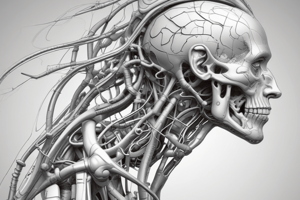Podcast
Questions and Answers
What distinguishes the three different classes of levers found in the human body?
What distinguishes the three different classes of levers found in the human body?
where the components of the lever are located
Matter is __________.
Matter is __________.
something that has mass and occupies space
The ankle is a third class lever.
The ankle is a third class lever.
False (B)
Swinging a tennis racket against a ball is an example of a third class lever.
Swinging a tennis racket against a ball is an example of a third class lever.
What is BEST to say about a runner who is running at a constant velocity?
What is BEST to say about a runner who is running at a constant velocity?
What lever has resistance between the axis (fulcrum) and the force (effort)?
What lever has resistance between the axis (fulcrum) and the force (effort)?
Second and third class levers both have __________.
Second and third class levers both have __________.
According to Newton's second law of motion, force is equal to mass times acceleration.
According to Newton's second law of motion, force is equal to mass times acceleration.
Second and third class levers are differentiated by __________.
Second and third class levers are differentiated by __________.
Which of the following is NOT a component of a lever?
Which of the following is NOT a component of a lever?
What distinguishes mass from weight?
What distinguishes mass from weight?
The elbow is considered a third class lever because __________.
The elbow is considered a third class lever because __________.
The first class lever is the most common lever in the human body.
The first class lever is the most common lever in the human body.
What is the difference between velocity and acceleration?
What is the difference between velocity and acceleration?
Force is based upon both mass and acceleration.
Force is based upon both mass and acceleration.
When the force on an object increases, so does its __________.
When the force on an object increases, so does its __________.
Flashcards are hidden until you start studying
Study Notes
Lever Classes
- Three classes of levers in the human body differ based on the arrangement of components: fulcrum, force, and resistance.
- Second class levers have the load located between the fulcrum and the effort.
- Third class levers have the force applied closer to the fulcrum than the load, as seen in the elbow.
Physical Concepts
- Matter is defined as anything that possesses mass and occupies space.
- The distinction between mass and weight: mass measures the amount of matter in an object; weight measures the gravitational force acting on it.
Motion and Forces
- A runner moving at constant velocity has zero acceleration.
- According to Newton's second law, force equals mass multiplied by acceleration, highlighting the relationship between these physical quantities.
- When force on an object increases, its acceleration also increases, demonstrating direct proportionality.
Specific Examples
- Swinging a tennis racket represents a third class lever in action.
- The elbow functions as a third class lever due to the positioning of the effort relative to the fulcrum and load.
- The first class lever is not the most prevalent in the human body; the third class lever is the most common.
Misconceptions and Clarifications
- The ankle does not function as a third class lever; it has a different mechanical arrangement.
- Tension is not a component that characterizes a lever.
- It's crucial to differentiate between velocity, which indicates speed, and acceleration, defined as the rate at which velocity changes.
Studying That Suits You
Use AI to generate personalized quizzes and flashcards to suit your learning preferences.




